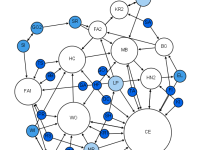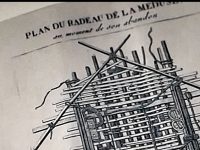Art and design. Into the orgasmatron! The Institute of Sexology hits the spot

EXHIBITION. I am sitting inside a small, metal-lined cabinet trying my utmost to feel sexually charged. This is a recreation of Wilhelm Reich’s “orgone accumulator”. The psychoanalyst claimed that if you sat inside his machine, preferably naked, it would unleash your inner libidinous energy.
I am not naked, sadly, though I have taken my pullover off. I am feeling oddly satisfied and relaxed. Even without the door, which has mysteriously disappeared, there’s a feeling of being wonderfully self-contained, cut off from the workaday world.
As well as energising you sexually, Reich said his orgone accumulator cured cancer and other diseases – a claim that led the US authorities to brand him a fraudster, destroy his boxes, burn many of his books and put him in prison, where he died in 1957. Since Reich was an Austrian of Jewish heritage who had fled the Nazis, there is an ugly irony in the book-burning.
Reich’s machine, which might be better called an orgasmatron after Woody Allen’s Sleeper (the 1973 film being shown alongside it), is part of the Institute of Sexology exhibition at the Wellcome Collection. You can’t move at the London show for large, erect members – on ancient Peruvian pottery, Greek vases and Japanese prints of couples in unlikely sexual positions. But the real stand-out is the elephant. A bull elephant’s penis is, as you might imagine, not insignificant. But more remarkable is what it can do with it. The thing seems, as the show’s co-curator Kate Forde says as we wander around, “to have a life of its own”. The muscle control is extraordinary.
The elephants star in a 35-minute film of animals copulating that comes from the archive of the pioneering American sexologist Alfred Kinsey. Kinsey acquired it from a biologist who specialised in porcupines, and they too feature in the film. When porcupines mate, the female uses her tail as a shield to protect the male from her spines. The male reciprocates by “anointing her with a urinary shower”, as the film has it. Some might think this an accurate summing up of male-female relations.
Agitated cats, dogs, horses and mink also appear. Pigs, too, though they adopt a more mechanical approach to mating. As for the sheep, they seem to have as little interest in sex as in anything else. There are also a pair of gay guinea pigs, which fascinated Kinsey, who reckoned few of us are exclusively hetero or homo and, if presented with an opportunity, would happily, like many animals, get it on with someone of our own sex. Kinsey has never been forgiven for his conclusions by conservatives in the US, who argue his research was primarily a means of rationalising his own sexual confusion.
Forde, though, sees Kinsey and the other sexologists celebrated in this show as liberators. The starting point of the exhibition is the library of the German sexologist Magnus Hirschfeld, whose Institute for Sexual Research flourished in Berlin in the 1920s, but was shut down by the Nazis, who ceremonially burned the archives. Hirschfeld – gay, Jewish, socialist, everything the Nazis despised – fled, and died in France two years later. The exhibition, envisaged as rising from the Nazi flames, is a homage to Hirschfeld’s institute.
The show is divided into sections: “library” (the early collectors); “consulting room” (Freud); “tent” (the anthropologists who celebrated the sexual freedom of the Pacific islanders they studied); “classroom” (Kinsey, who migrated from collecting wasps to collecting people’s sexual histories when he started teaching a course on marriage at Indiana University); “laboratory” (the research into sexual arousal by Virginia Johnson and William Masters at Washington University in the 1960s); and “home” (an assessment of the work in the UK of the National Survey of Sexual Attitudes and Lifestyles, which was launched in the wake of the Aids panic in the 1980s, the first time the British had gone beyond a saucy-postcard view of sex). These sections have a somewhat arbitrary feel, and to some extent you have to join the dots in the chronological story yourself. But there are plenty of suggestive signposts along the way, and the occasional randomness may be in keeping with the exhibition’s anti-repression message.
Germany provided several of the great early sexologists, including the man who could claim to be the daddy of the discipline – Richard von Krafft-Ebing. His 1886 book Psychopathia Sexualis, which catalogued fetishism, sadism, masochism and other so-called deviant behaviour, was deemed so racy parts were written in Latin. Krafft-Ebing, unlike most of the later sexologists, was no liberal. He thought sex should be exclusively for procreation, and that recreational sex was unnatural. A formal photograph of him seated with his sturdy wife, who is dressed in a heavy black gown, emphasises his conservatism, although, stamped on the print, the name of the company that took the picture seems to provide its own commentary: Schulz and Suck.
But why were so many of the sex pioneers German? Forde says Germany led the way in all the sciences in the 19th century, and that sexology was a byproduct of the interest in psychiatry. She also thinks being landlocked had something to do with it, producing a collective introversion. By contrast, the British – hooked on cold showers and pursuit of empire – were latecomers to the party. Indeed, the curators make a little joke about our embarrassment when it comes to sex by juxtaposing a 19th-century French booklet praising “Les charmes de la masturbation” with an English publication, The Secret Companion, in which a gentleman is shown lying exhausted on a chaise longue in a section called “On Onanism as a cause of sexual debility”.
The Edinburgh-born Marie Stopes countered British repression and reserve in her controversial – and hugely successful – book Married Love. Published in 1918, it argued that good sex was vital to a good marriage and that the sexual needs of both partners had to be taken into account. Previously, women were not just denied the vote; they were not meant to have orgasms either. The exhibition includes correspondence she received after publication: praise from some for her openness, vilification from others. “Decent English people are disgusted at your filthy suggestions,” says one letter. “Sexual gratification is not the only thing that makes life worth living, as you seem to think.” The word decent is heavily underlined.
Stopes, like Hirschfeld, linked sexual freedom with other freedoms. Where Hirschfeld campaigned for gay rights, Stopes supported birth control and women’s political rights – she was a committed suffragette. In that sense, the exhibition is as much about politics as it is about sex. Sexual intolerance has always gone hand in hand with a broader repression, and in many parts of the world still does.
The Institute of Sexology is the first exhibition at the expanded Wellcome Collection, and the curators know they are on to a winner. “I have been trying to say to everyone I meet, ‘It’s not really about sex, it’s about the study of sex, the science of sex,’” says Forde. “That’s quite an important distinction.” It won’t work, of course. There’s sure to be a queue stretching down the road. “We’ve already had some interesting calls volunteering material. We asked for it really, I suppose.”
• The Institute of Sexology opens at the Wellcome Collection, London NW1 on 20 November.










